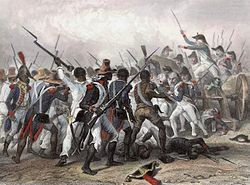| This article relies largely or entirely on a single source. Relevant discussion may be found on the talk page. Please help improve this article by introducing citations to additional sources. Find sources: "1796 Boca de Nigua slave revolt" – news · newspapers · books · scholar · JSTOR (January 2025) |
| 1796 Boca de Nigua Rebellion | |||
|---|---|---|---|
| Part of The Slave Revolts in North America and Age of Revolution | |||
 Map of eastern Hispaniola, (present-day Dominican Republic), by Casimiro Nemesio de Moya. Map of eastern Hispaniola, (present-day Dominican Republic), by Casimiro Nemesio de Moya. | |||
| Date | October 26, 1796 (1796-10-26); 228 years ago | ||
| Location | Nigua Sugar Mill, Colony of Santo Domingo | ||
| Goals |
| ||
| Resulted in | Suppression of the revolt | ||
| Parties | |||
| |||
| Lead figures | |||
|
Francisco Sopo Juan Bautista Oyazábal | |||
| Part of a series on |
| North American slave revolts |
|---|
 Attack and capture of the Crête-à-Pierrot (Combat et prise de la Crête-à-Pierrot, March 1802) in the Haitian Revolution by Auguste Raffet, engraving by Ernest Hébert Attack and capture of the Crête-à-Pierrot (Combat et prise de la Crête-à-Pierrot, March 1802) in the Haitian Revolution by Auguste Raffet, engraving by Ernest Hébert |
| Context |
|
Before 1700
(Spanish Florida, victorious)
(Real Audiencia of Panama, New Spain, suppressed)
(Veracruz, New Spain, victorious)
(New Spain, suppressed)
(New Spain, suppressed)
|
|
18th century
(British Province of New York, suppressed)
(British Jamaica, victorious)
(British Chesapeake Colonies, suppressed)
(Louisiana, New France, suppressed) (Danish Saint John, suppressed)
(British Province of South Carolina, suppressed)
(British Province of New York, suppressed)
(British Jamaica, suppressed) (British Montserrat, suppressed)
(British Bahamas, suppressed)
(Louisiana, New Spain, suppressed) (Louisiana, New Spain, suppressed) (Dutch Curaçao, suppressed)
|
19th century
(Virginia, suppressed)
(St. Simons Island, Georgia, victorious)
(Virginia, suppressed) (Territory of Orleans, suppressed)
(Spanish Cuba, suppressed)
(Virginia, suppressed)
(British Barbados, suppressed)
(South Carolina, suppressed) (Cuba, suppressed) (Virginia, suppressed)
(British Jamaica, suppressed)
(off the Cuban coast, victorious)
(off the Southern U.S. coast, victorious) (Indian Territory, suppressed)
(Spanish Cuba, suppressed) (South Carolina, suppressed)
|
| Notable leaders |
The 1796 Boca de Nigua Rebellion was a slave rebellion that occurred in what is now Dominican Republic. This was the largest slave revolt to erupt in Dominican history.In the end, the revolt was brutally suppressed. However, this laid the foundations for the defense of the human rights of blacks in Santo Domingo, which continued to remain a social issue well into the mid-19th-century.
History
As with previous slave leaders, such as Diego de Ocampo, Sebastián Lemba, and Diego Vaquero, the fight against slavery had been planted in the minds of Santo Domingo's slaves. Motivated by the Haitian Revolution that had been taking place in neighboring Saint-Domingue, the blacks of Boca de Nigua took the slave owners by storm and started a liberation movement in eastern Hispaniola, which is now known as the Dominican Republic. Amid fire and drums, the slave revolt broke out. On October 30, 1796, at the Boca de Nigua Sugar Mill, administered by the Spanish nobleman Juan Bautista de Oyazabal and owned by the Duke of Aranda, the crew of 200 slaves set out to carry out a full-scale rebellion. They proceeded to destroy and burn the agricultural plantations and all the symbols that chained them to the regime: sugarcane fields, houses and all the property of the master. Oyazabal tried to repel the rebellion with the help of some whites, but it proved to no avail. Oyazabal had to go to the city and appeal to the governor of the island, Joaquín García y Moreno, to obtain military aid. With a military force full of sophisticated weapons, cannons, shrapnel and specialized men, they went out against the rebels.
After great battles, the Spanish slave owners managed to disperse the rebels towards the forest and other areas surrounding the sugar mill. Later, with the payment of rewards, an operation was carried out to arrest the rebellious slaves. The goal was to capture the entire rebel crew. They executed the two foremen who were in the sugar mill, one drowned inside a liquor pipe and the other with whippings in return for the daily whipping he brandished on the backs of the black workers. There were casualties on both sides. Of the rebels, 7 were killed and 69 taken prisoner, a situation that paralyzed the triumph of the emancipation of the blacks. A number of whites were killed and wounded. The rebels were sentenced a month later. Some were beheaded, others received one hundred lashes in the public pillory, and others were sentenced to exile to serve sentences in prisons in Panama, Cuba, Colombia and Mexico.
Boca de Nigua has been an event of great significance. This was the cost of the Black Rebellion of Boca de Nigua, which, although it did not immediately achieve its intended objective, weakened the foundations of slavery to the extent that the rebels managed to spread their libertarian ideal throughout all the sugar mills of the time.
See also
References
- Group, 2006-2020, Merit Designs Consulting. "America's first black slave rebellion turns 500 years today". DominicanToday. Retrieved 2025-01-05.
{{cite web}}: CS1 maint: numeric names: authors list (link)
This Dominican Republic-related article is a stub. You can help Misplaced Pages by expanding it. |